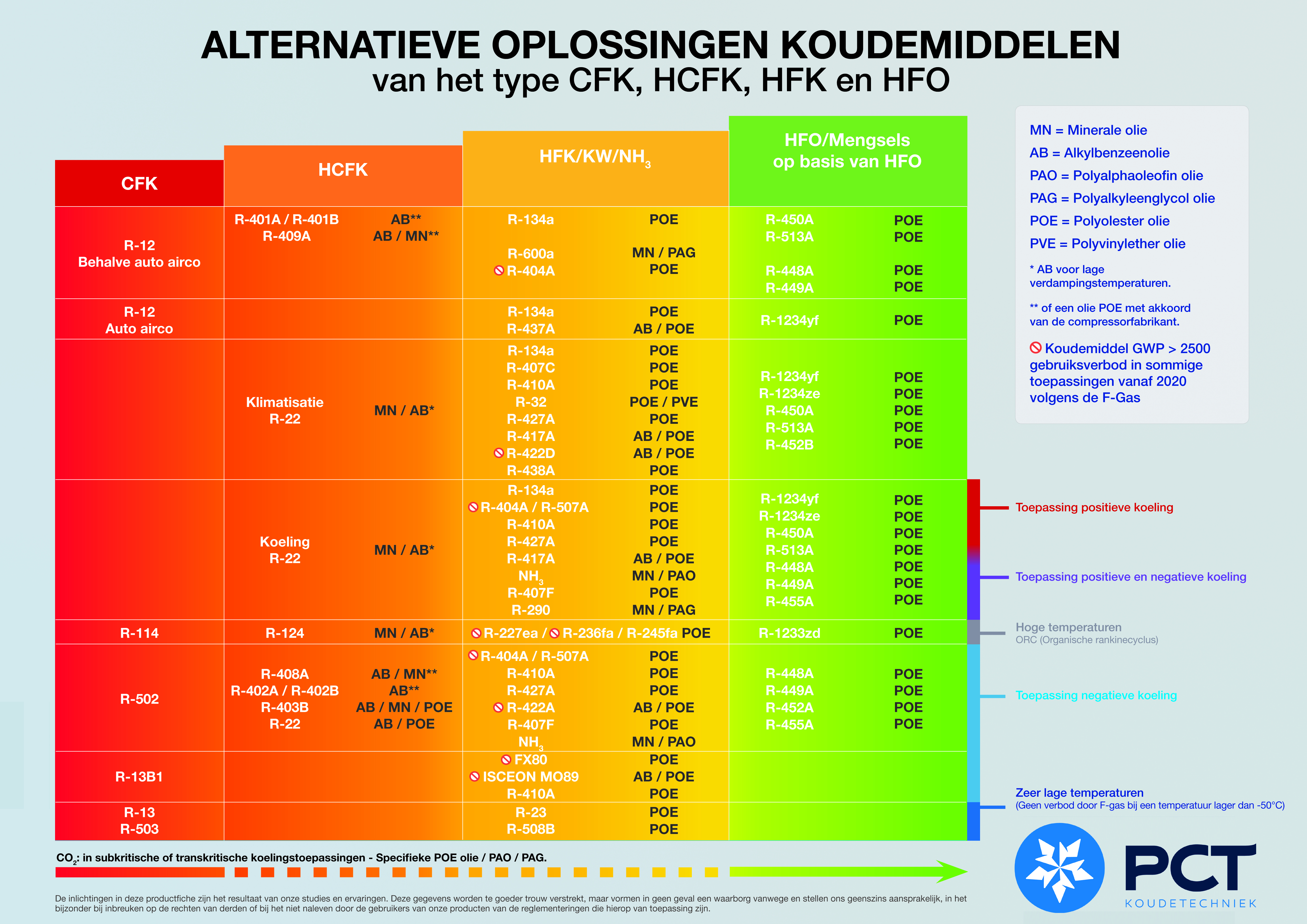-
 THE PERFECT DEGREEº
THE PERFECT DEGREEº
Consequences of Phase-Out
If you still have an installation with a synthetic refrigerant, it is highly likely that the new legislation will affect your business operations. We will outline the consequences and solutions for each refrigerant.
**R22 INSTALLATIONS**
Even blends containing R22 are prohibited. Cooling installations with R22 are allowed to continue operating, but refilling is no longer permitted. In the event of a leakage, an R22 cooling installation may be out of service for an extended period, jeopardizing the continuity of business processes.
**CONSEQUENCES FOR R22**
According to European legislation (Ozone-Depleting Substances Regulation – EC 1005/2009), R22 refrigerant in your cooling installation is not banned. Therefore, your installation can continue to operate after January 1, 2015. According to the regulation, &/en/pages/consequenties-uitfasering#39;use&/en/pages/consequenties-uitfasering#39; for new construction and service purposes is prohibited (Article 3). Refilling or topping up installations with R22 refrigerant falls under &/en/pages/consequenties-uitfasering#39;use&/en/pages/consequenties-uitfasering#39; and is thus prohibited. This means that an existing R22 installation can continue to operate, but no actions with the refrigerant outside the installation are allowed. In the event of a leakage, your R22 installation is at risk of being out of service for an extended period.
**R404A AND R507A INSTALLATIONS**
The F-gas legislation accelerates the phase-out of refrigerants R404A and R507A. These are gases with a GWP (Global Warming Potential) above 2,500. From January 1, 2020, you can only refill your installation with recycled R404A or R507A. From January 1, 2030, the use of these refrigerants is entirely prohibited. The ban does not apply to:
- Installations with a capacity <10 kg.
- Freezing applications operating at a temperature <50ºC
- Military equipment
Furthermore, the production of refrigerants R404A and R507A is rapidly being reduced.
**CONSEQUENCES FOR R404A and R507A**
If you have an R404A or R507A installation, you can continue to operate it. However, there may be a shortage of recycled refrigerant. From January 2015, the production of these refrigerants will be gradually phased out. From January 1, 2020, R404A and R507A refrigerants can no longer be produced. From that date, installations can only be refilled with regenerated R404A and R507A. It is expected that shortages of regenerated R404A and R507A refrigerants will occur, leading to price increases. Refilling installations with R404A and R507A will become significantly more expensive.
**R134A, R407C, AND R410A INSTALLATIONS**
There is a production restriction for synthetic refrigerants with a GWP value <2,500. This includes commonly used refrigerants such as R134A, R407C, R407F, and R410A. The production of refrigerants R134A, R407C, R407F, and R410A is gradually being reduced. In 2020, the total production of synthetic refrigerant will be reduced by approximately 40%. By 2030, only 20% of the currently produced synthetic refrigerants can be brought to market.
For this group of synthetic refrigerants, there is no use ban. This means that R134A, R407C, R407F, and R410A installations can still be refilled after 2030. However, the expectation in Europe is that all synthetic refrigerants will be banned in the long term.
**CONSEQUENCES FOR R134A, R407C, and R410A?**
In the near future, there will be significantly less synthetic refrigerant available, leading to price increases. Refilling an installation with a synthetic refrigerant will become significantly more expensive. There may even be shortages of certain types of refrigerants.
**SOLUTIONS**
If you have a cooling installation with a synthetic refrigerant, you have four choices:
1. **Continue Operating:**
Reliable and well-maintained R22 installations without leaks can continue to operate after 2015. It is allowed to repair your R22 cooling installation and replace components. However, temporary pumping out of the refrigerant is not allowed. Repairs requiring the pumping out of R22 are prohibited. Refilling with R22 is also forbidden.
If cooling is crucial for your business process, continuing with the installation may be less suitable for you. In the event of a leakage, the installation may be out of service for an extended period because, after January 1, 2015, there is a ban on refilling cooling installations with R22. If you choose this scenario, we recommend regularly checking your cooling installation.
2. **Drop-In:**
A drop-in involves pumping out the refrigerant and replacing it with an alternative refrigerant or topping up with an alternative refrigerant. This scenario is suitable for installations younger than 10 years and already prepared for the use of a synthetic refrigerant. Disadvantages of a drop-in include reduced cooling capacity, increased energy consumption, and a shortened lifespan of the installation. In many cases, a drop-in is less suitable as a permanent solution.
3. **Conversion:**
It is possible to adapt your cooling installation for an alternative refrigerant. Cooling with natural refrigerants also becomes possible. Some components are then replaced. This scenario is suitable for large, well-maintained industrial cooling installations. In modified form, they can continue to operate for years, avoiding premature high investments.
4. **New Construction / Replacement:**
Replacing installations with synthetic refrigerants with natural refrigerants in your cooling installation is a sustainable solution. More and more new cooling installations run on natural refrigerants such as R744 (CO2 or carbon dioxide) or R717 (NH3 or ammonia). These solutions are environmentally friendly and very energy-efficient. This way, you also comply with legislation in the long term. Additionally, as a business owner, you can benefit from attractive tax incentives. Several entrepreneurs have achieved significant financial savings through this.
Business cooling
Unit construction
Service
Contact
Daalder 15753 SZ Deurne
T: +31 493 319217
Waanderweg 34
7812 HZ Emmen
T: +31 591 246180
E: info@pct.nl
KVK: 17137993





